
CAPTAIN AMERICA
This article was originally published in MARVEL AGE Vol. 1, No. 57, December, 1987
Nearly a half-century ago, a frail youth named Steve Rogers wished to enlist in the U.S. Army in order to help combat the Nazi threat in World War II. But, due to his poor physical condition, he was rejected. His perseverence, however, brought him to the attention of Dr. Abraham Erskine, the creator of the Super-Soldier formula.
Acting as Erskine’s guinea pig, Steve Rogers was administered the serum. The result: Rogers was transformed into the greatest soldier the world has ever known — Captain America! Throughout the war, he served as a special operative to the U.S. government and was revered as a symbol of freedom, a “living legend.” Toward the end of the war an accident threw Captain America into a state of suspended animation. Many years later he was revived and continued to serve as America’s symbol of justice and liberty.
Until now.
In CAPTAIN AMERICA #332, Steve Rogers resigned. The President's Commission on Super-Human Activities confronted him with the cold, hard fact that the government created the concept of Captain America, not him. They informed him that he is just an actor playing the role created by bureaucrats. Since they own the concept, they decreed that Captain America should work for them and play by their rules. In essence, they wanted him to resume his official status as America’s Super-Soldier, as per the terms of a contract he signed in 1941. As such, all his activities would be assigned and coordinated by the federal government. As their operative, Cap would no longer be free to act autonomously. He would be answerable only to the government and would have to do as they ordered.
Since Steve Rogers has been an independent agent since his revival from suspended animation, he found it difficult to imagine relinquishing his personal freedom. He felt that he had served the country well for years without bureaucratic direction. In fact, he asserted, working for the government would compromise his ability to represent the American people! Instead, he'd become more of a symbol of the American government like the President. Therefore, making the most difficult decision he has ever faced, Steve rejected their conditions for employment. In doing so, he gave up his shield, his uniform and the very name Captain America!

Subsequent issues of CAPTAIN AMERICA will focus on the man the Commission hired to replace Steve: John Walker, the original Super-Patriot. Walker had an older brother who was killed in the Vietnam conflict. Hoping to live up to his brother's heroism, he enlisted in the army as soon as he was old enough, which was long after the war had ended. Seeing no action in the service, he and a few of his army buddies learned of an organization called Power Broker, Inc., which specialized in granting people super-human strength. Walker thought he might be able to become a hero by increasing his strength.
Rather than join the Unlimited Class Wrestling Federation to pay for his treatment, as did most of Power Broker's enhanced individuals, John met an unscrupulous promoter named Ethan Thurm, who was the Beyonder’s manager during his brief wrestling career. Thurm helped John develop the identity of the Super-Patriot and sent him around the country promoting patriotism and the American Dream. Walker's idea of the American Dream, however, was quite different from that of Steve Rogers. Walker believed the American Dream to mean pure capitalism, the opportunity to make a lot of money by ingenuity, hard work and shrewd investments. His means to achieve this dream was by exploiting patriotism.
“Basically, John Walker's heart is in the right place,” said CAPTAIN AMERICA writer Mark Gruenwald. “He wants to be a good man — a hero. But unlike Steve Rogers, he sees nothing wrong with using his power and position for personal gain. I guess he's got a very yuppie view of heroism. Make no mistake, Walker is a patriot — he loves America just as much as Steve Rogers does. But other than that, anything that can be different about two men is different, including their background, their ideals and their concept of morality.
“Walker's love of capitalism isn't ugly or un-American,” Mark added, “it just has nothing to do with what Captain America stood for before.”
John Walker has more of a Rambo mentality than Steve Rogers. He believes that “might makes right,” and being an American means always being right.
The early storylines in this saga will focus on John's attempts to determine just what his country (i.e. the government) demands from a Captain America. He started his career as the Super-Patriot by cutting down Captain America, preaching that Cap wasn't a viable or representative concept responsive to the will of the nation today. Now that he has literally become his opponent, he finds that representing a nation of almost 300 million people is trickier than he thought.
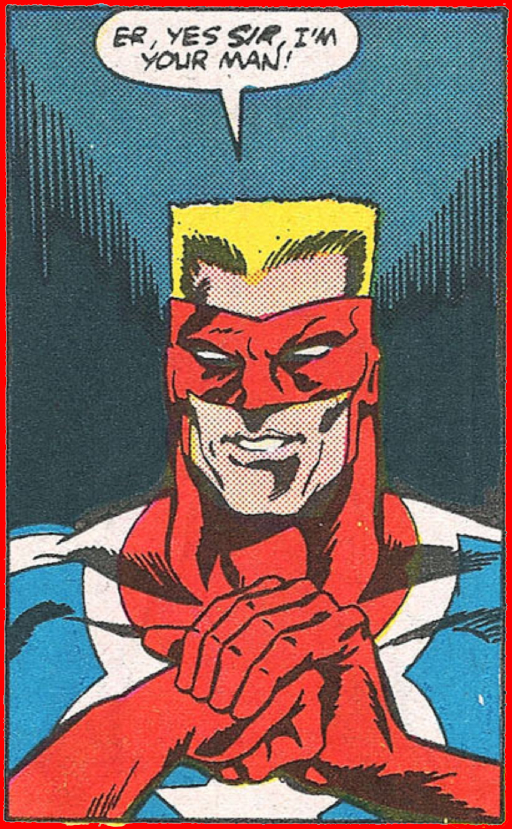
“Fans will discover that, unlike Steve Rogers who's had decades of experience, this Captain America can't always make the right decisions, can't always do the good thing, and doesn’t automatically know what the good thing is in every circumstance,” Mark said. “I hope they will learn something about what it means to be Captain America.”
Mark Gruenwald originally conceived this storyline in response to a certain question often asked in fan mail: “Does Captain America automatically support the decisions and policies of any presidential administration, or does he have a mind of his own?”
“I realized that the reason why people were asking this question was because no CAP writer has ever done a story which brings this issue into sharp focus: Just what is the relationship today between Cap and the government? Judging by the mail, I think fans have a lot of erroneous assumptions about Captain America’s personal beliefs,” Mark explained. “They somehow think he should be a conservative Republican despite the fact that he assumed his position during FDR's Democratic era. Cap is truly nonpartisan, not liberal or conservative. He doesn't represent any particular administration. He represents the entire country and its people.”
In this storyline, Mark says that Steve Rogers is in for the worst time of his life. “You can't do anything worse to him than force him not to be Cap! It attacks the very foundations of his beliefs and the career he has devoted his life to.”
As John Walker tries to live up to the Commission's expectations of Captain America, Steve Rogers will try to become the best hero he possibly can be, despite the incredible restrictions he must work under. Among other things, the Commission has slapped an injunction on him, forbidding him to wear red, white and blue. They don't want Steve to become a rival Captain America.
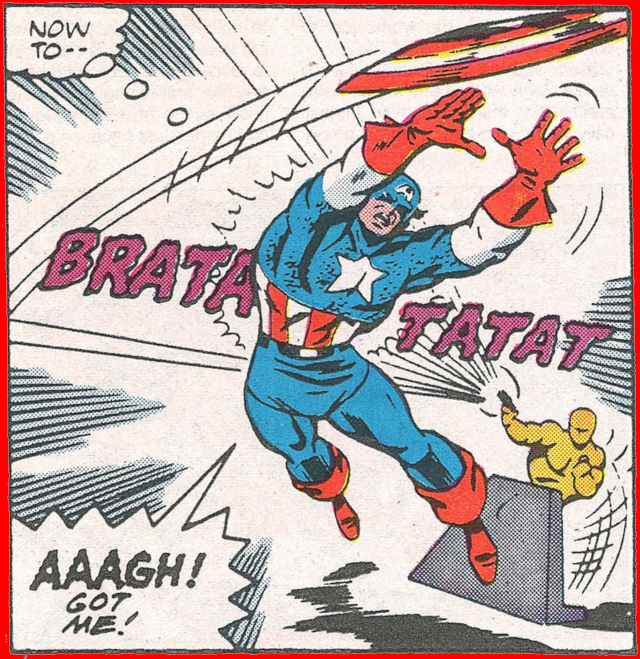
Undaunted, Steve dons a costume colored red, white and black and assumes the name “the Captain.” He will be aided in his new adventures by three of his former partners: the Falcon, Nomad and Demolition Man. Meanwhile, the new Captain America will be aided by a new Bucky, whose strength was also augmented by the Power Broker. Of course, those two plotlines will converge to an eventual meeting between the two Caps.
“We'll be treating CAPTAIN AMERICA as a team book for a while,” Mark Gruenwald said. “On the one hand we have the Captain and his former partners, and on the other we have the new Captain America and Bucky. We may even throw a new Super-Patriot into the works just to confuse everybody.”
Mark expects that fans will initially dislike John Walker but will come to realize that there is nothing intrinsically wrong with him. “He's got a very tough act to follow and big boots to fill. He's doing his best but he just may not be up to it,” he said.
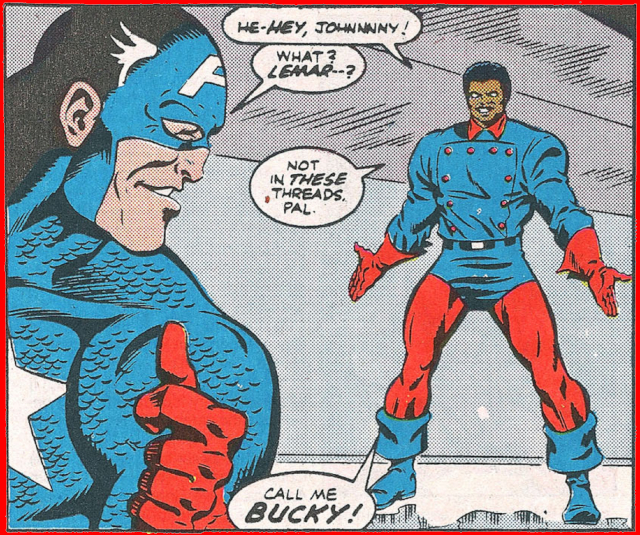
“I also hope the fans gain a new respect for Steve Rogers, a man who is so committed to his ideals that he is willing to walk away from everything that is meaningful to him.” Mark points out that it will be very difficult for the Captain to operate without his reputation backing him up. In fact, in one of his first adventures, Steve gets arrested for interfering with the law, something that never would happen to someone with Captain America’s credentials. But he is determined not to reveal to the public that he was the original star-spangled Avenger, in order not to give the government a bad name. Just because government representatives did him an injustice, he has no desire to promote widespread bad faith in the government itself. Although he no longer has the actual reputation of Cap to live up to, Steve must now continue to live up to his own self-image of what a hero should be.
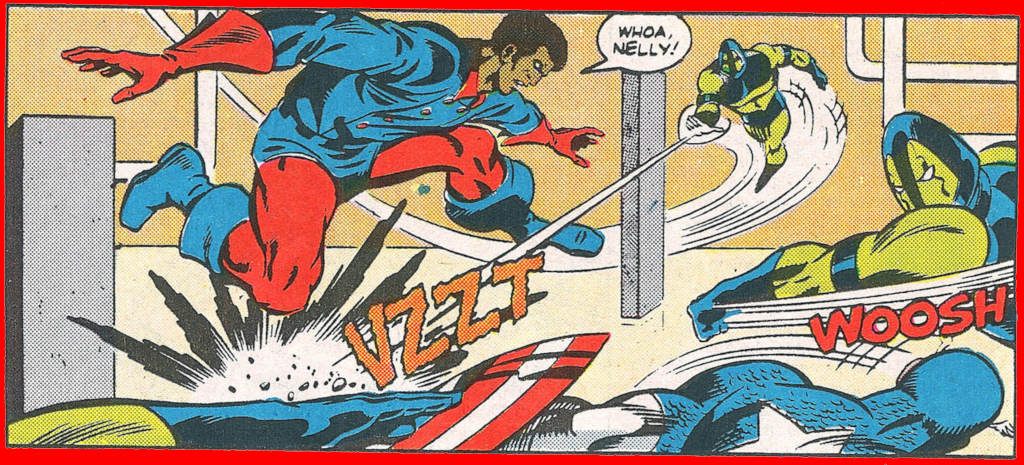
The last time Captain America abandoned his uniform, he developed the guise of Nomad, “the man without a country.” But that was of his own free choice, when Steve was questioning his patriotic identity. The Nomad character was an attempt to make a political statement. Steve's new identity has no such symbolic meaning. His new costume is just working attire for a hero trying to do his job.
A number of new villains as well as familiar ones will be appearing in this saga. In some cases the new Captain America will battle an established felon from the past who is not expecting a different man in the uniform, especially one that can press 10 tons! On the other hand, the Captain will go up against some of his old foes, who will be equally dumbfounded by the change of costume.
Specifically, the Serpent Society will plan the most audacious scheme they've ever attempted. There will also be an X-FACTOR tie-in featuring Famine, one of the Horsemen of the Apocalypse.
In addition, Mark plans a crossover with IRON MAN, which will lead to a conflict between the Captain and the Armored Avenger as part of ShellHead's ongoing attempt to neutralize all other armored characters. Their battle indirectly facilitates the escape of many super-powered villains from the Vault, the government's new maximum-security prison which detains such criminals. The Captain takes it upon himself to bring them to justice.

Also in this crossover, Tony Stark will create a new shield for the Captain. Composed purely of adamantium, this shield will not be quite as good as the original. But who other than Tony Stark could create one nearly as good?
And speaking of Iron Man, what will he and the other Avengers say about this big change? Steve Rogers leaves a message on their answering machine saying that he is taking an extended leave of absence. He tells the Avengers that, due to their own problems with the government lately, it would not be in the team’s best interest to associate with him. How they react remains to be seen.
Newcomer Kieron Dwyer will be assuming the penciling chores in issue #338. “Kieron is one of the most fluid, dynamic artists this book has had since John Byrne drew nine issues back in '81,” Mark observed. “This is his first regular assignment and I think readers are going to be amazed to see how quickly he develops into a major talent.
“This is the most exciting period in Cap's life yet,” Mark promises. “Anything can happen. We don't even know at this point if Steve Rogers will get his old suit back or if the new Cap will succeed.” For the sake of the free world, let's hope that Captain America, in whatever guise, lives up to his reputation as “the living legend.”
—Glenn Herdling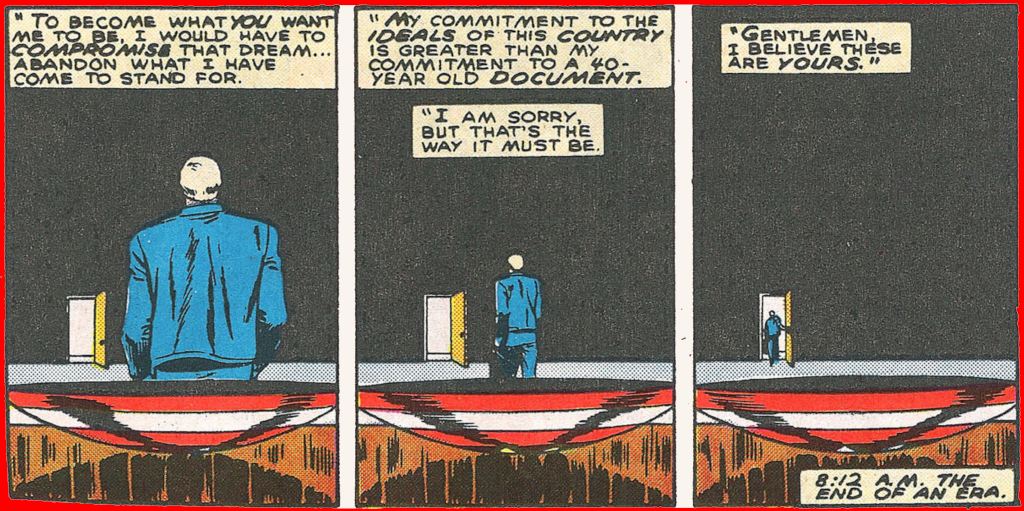
Article © 1987 Marvel Entertainment Group, Inc. Web Site © 2018-2024 DonValor



